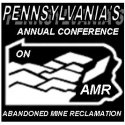
Legend: CAMBRIAN, ORDOVICIAN, SILURIAN, DEVONIAN, MISSISSIPPIAN, PENNSYLVANIAN, PERMIAN, TRIASSIC, JURASSIC, CRETACEOUS, TERTIARY, QUATERNARY.
Coal is an organic sediment consisting of a complex mixture of substances. Depending upon the evolutionary developmental phase of coal formation there are:
 The first evolutionary phase is peat which is little more than wood pulp that has been badly decomposed. There are large deposits of peat in the Scandinavian countries and Greenland. One can strip mine it since it is basically very close to the ground level. The problem with peat is that it has a very low British Thermal Units (BTU) production per pound of the fuel burned. In addition, strip mining is ecologically very destructive unless the mining company makes a conscious effort to restore the countryside. Strip mining is the process of scraping the coal from the top surface of the ground.
The first evolutionary phase is peat which is little more than wood pulp that has been badly decomposed. There are large deposits of peat in the Scandinavian countries and Greenland. One can strip mine it since it is basically very close to the ground level. The problem with peat is that it has a very low British Thermal Units (BTU) production per pound of the fuel burned. In addition, strip mining is ecologically very destructive unless the mining company makes a conscious effort to restore the countryside. Strip mining is the process of scraping the coal from the top surface of the ground.
The second phase in the evolutionary development of coal is lignite. Lignite is found in great quantities in the Western part of the US. Again lignite is not particularly efficient in producing energy per mass of fuel. There have been quite a bit of effort recently in the liquification and gasification of lignite. Liquification converts lignite into liquid crude petroleum. Gasification plants convert lignite into natural gas products. The conversion process is quite expensive, and with the present cost of other forms of fuel, it is economically infeasible. However, if other fuels become too expensive, this could be a more economical process. Other research has been conducted investigating other uses of lignite such as a fertilizer in hydroponic plant growth. Hydroponics is the use of nutrient containing water instead of soil in the growth of plant life.
A third phase in this coal development is bituminous (soft coal) which is one of the two stages used as a fuel in generating electrical power. The fourth and final phase results in the formation of anthracite (hard coal). If anthracite coal was placed under more heat and pressure, it would eventually be compressed into a diamond.
Two broad categories of coal and peat
Humic – More common and originates from peat deposits consisting mostly of organic debris deposited “in situ” – in its original place (autochthonous).
Sapropelic – Derived from redeposited (allochthonous) resistant plant fragments such as spores or aquatic plants.
The sapropelic coals can be further subdivided into:
Cannel coal – Made up principally of uniformly sized plant fragments (eg. spores)
Boghead coal – Consists mainly of alginite (an algae “coal maceral” – dehydrogenated plant fragments).
 The type of original plant input, the availability of nutrients, climatic conditions, the level of the water table, the pH and Eh conditions all help to determine the type of peat that is formed (and eventually the mine drainage that comes from the bed).
The type of original plant input, the availability of nutrients, climatic conditions, the level of the water table, the pH and Eh conditions all help to determine the type of peat that is formed (and eventually the mine drainage that comes from the bed).
Peat is formed from the deposition of organic material with a restricted supply of oxygen. Peat forming environments are known generally as ‘mires’.
Limnic deposits – Peat forming environments isolated from the sea (inland swamps and lakes).
Every part of the ecosystem of the peatland or mire may be represented in the peat, including the large trees, herbaceous shrubs, grasses, aquatic plants and the micro-organisms that break down the organic material.
For a coal to be developed, the peat has to be buried and preserved. The process that converts peat to coal is called coalification. The degree of coalification which has taken place determines the rank of the coal.
Formation of Coal (aka. Coalification)
The transformation of plant material into coal takes place in two stages, biochemical degradation and physico-chemical degradation.
Biochemical degradation involves chemical decomposition of botanical matter assisted by organisms.
In tropical environments, this process may be faster, since the warm moist conditions are ideal for the organisms that assist in this process such as bacteria and fungi. However plant growth is also more rapid and so the increased rate of decomposition may be balanced by plant growth. In tropical conditions high rates of evaporation need to be coupled with high precipitation to maintain plant growth and peat accumulation.
In cooler climates the growth rate of vegetation may be cyclical in nature and slower since the seasonal variation in conditions is greater. The conditions are less ideal for fungi and bacteria so the slower growth rate is matched by a slower rate of biochemical degradation.
Humification affects the soft contents of the plants cells before the cell walls, which consist of cellulose, hemicellulose and lignin which is the most resistant compound. Humification begins with the oxidation of plant matter and attack by aerobic organisms such as fungi, insects and aerobic bacteria. Hydrocarbons are extracted from the tissue and the material left behind is relatively enriched in oxygen and carbon. Semifusinite, an inertinite maceral may be formed in this manner. Various humic substances are formed at this time, these are acidic in nature. If this continues the plant material will be completely degraded into carbon dioxide and water. When the plant material or degraded plant material is buried below the ground water table aerobic organisms and oxidation can no longer attack the material. Anaerobic bacteria may still decompose the plant matter until it reaches a depth or conditions unsuitable for these organisms. Anaerobic bacteria utilise the oxygen in the plant matter, so all molecules may be attacked even the more resistant compounds. However the softer tissue may be more rapidly affected.
Biochemical coalification ends at the rank of sub-bituminous coal, when humic substances have polymerised.
Physico-chemical coalification which follows is caused by conditions of burial (ie. heat and pressure).
The overburden which is deposited, the heat flows in the earth’s crust and tectonic heat and pressure change the chemistry and structure of the altered organic material. The same conditions are applied to all the coal macerals. Water is squeezed out and pore size is reduced as pressure increases and oxygen and hydrogen are released during thermal cracking. Water and carbon dioxide are the first products released. When rank reaches medium volatile bituminous coal demethanation begins.
Concept of Coal Rank
The rank of a coal refers to the degree of coalification endured by the organic matter. It is estimated by measuring the moisture content, specific energy, reflectance of vitrinite or volatile matter (these are known as rank parameters). See Table 1 for details of the different rank stages.
Table 1. From Diessel (1992) indicates the difference in rank parameter with increase in rank.
| %carbon | %volatile matter | specific energy | % in situ moisture | % vitrinite | reflectance random max | |
| wood | 50 | >65 | ||||
| peat | 60 | >60 | 14.7 | 75.0 | 200. | 20 |
| brown coal | 71 | 52 | 23 | 30 | 0.40 | 0.42 |
| sub-bituminous | 80 | 40 | 33.5 | 5 0. | 60 | 0.63 |
| high volatile bituminous coal | 86 | 31 | 35.6 | 3 | 0.97 | 1.03 |
| medium volatile bituminous coal | 90 | 22 | 36 | <1 | 1.47 | 1.58 |
| low volatile bituminous coal | 91 | 14 | 36.4 | 1 | 1.85 | 1.97 |
| semi-anthracite | 92 | 8 | 36 | 1 | 2.65 | 2.83 |
| anthracite | 95 | 2 | 35.2 | 2 | 6.55 | 7 |
Methods of Mining
Most underground coal is mined by the room and pillar method, where by rooms are cut into the coal bed leaving a series of pillars, or columns of coal, to help support the mine roof and control the flow of air. Generally, rooms are 2,000 feet wide and the pillars up to 300 feet wide. At least 60 feet of coal was left between an underground mine and the surface, if not the surface had a higher probability of caving in. As mining advances, a grid-like pattern of rooms and pillars is formed. When mining reaches the end of a panel or the property line, retreat mining begins. In retreat mining, the workers mine as much coal as possible from the remaining pillars until the roof begins to fall in (aka. third mining or ‘robbing the pillars’). When retreat mining is completed, the mined area is abandoned.
There are two types of room and pillar mining–conventional mining and continuous mining.
Conventional mining is the oldest method and accounts for only about 12% of underground coal output. In conventional mining, the coal seam is cut, drilled, blasted and then loaded into cars.
Continuous mining is the most prevalent form of underground mining, accounting for 56% of total underground production. In continuous mining, a machine known as a continuous miner cuts the coal from the mining face, obviating the need for drilling and blasting.
Another type of continuous underground mining is called longwall mining. In longwall mining, the continuous miner cuts away long panels of coal and the ground is allowed to subside as the machine advances. This is known as controlled subsidence. Hydraulics support the roof immediately behind the cutting face. Often times the waste rock, or GOB, is deposited in the void left behind to reduce the subsidence distance.
Types of underground mines–shaft mines, slope mines and drift mines.

The decision of what type of mine to construct depends on the depth of the coal seam and the surrounding terrain.
Drift mines have horizontal entries into the coal seam from a hillside.
Slope mines, which usually are not very deep, are inclined from the surface to the coal seam.
Shaft mines, generally the deepest mines, have vertical access to the coal seam via elevators that carry workers and equipment into the mine.
Almost all underground mines are less than 1,000 feet deep and this is generally due to the ability to keep water pumped out of the mine. Some mines reach depths of over 2,000 feet where gravity drains can be constructed. Miners in Nova Scotia actually mine coal beneath the ocean.
A secondary byproduct of mining coal is the emission of greenhouse and other gasses which pollute the air. The most widely known type of air pollution from a fossil fuel such as coal is caused by the combustion of the fuel. Not many know that by simply creating openings in the ground exposes the coal and allows it to off-gas. Coal emits many gasses when exposed: Methane, Carbon Monoxide, Carbon Dioxide, Hydrogen, Hydrogen Sulfide, Nitrogen, and Sulfur Dioxide just to name a few. Miners knew these mine gasses as black damp, stinky damp, and white damp and would test the mine with a safety flame lamp daily to know if there was proper ventilation of these gasses. Canaries were also kept in cages in the mines. If the canary was singing, it was safe to enter the mine. If not, the canary had probably suffocated from the buildup of gasses in the mine and the mine needs to be ventilated.
Surface mining is accomplished by removing overburden from the coal seam and then blasting and removing the coal. The ratio of overburden excavated to the amount of coal removed is called the overburden ratio. The lower the ratio, the more productive the mine. The lowest overburden ratios are found in western surface mines. Often more than one coal seam is mined in one open pit, the excavated area. Overburden is carried away to a refuse pile (aka. culm or GOB pile).
There are several types of surface coal mines.
Area surface mines , usually found in flat terrain, consist of a series of cuts 100 to 200 feet wide. The overburden from one cut is used to fill in the mined out area of the preceding cut.
Contour mining, occurring in mountainous terrain, follows a coal seam along the side of the hill. When contour mining becomes too expensive, additional coal can often be produced from the mine’s highwall by the use of augers or highwall miners. Open pit mining is usually found where coal seams are thick and can reach depths of hundreds of feet.
Equipment used in surface mines include draglines, shovels, bulldozers, front-end loaders, bucket wheel excavators and trucks. In large mines, draglines remove the overburden while shovels are used to load the coal. In smaller mines, bulldozers and front-end loaders are often used to remove overburden.
Since 1977, mining companies have been required to reclaim surface mines back to the ‘approximate original contour’. Before that, companies would leave the pits and piles open, arguing that they may go back and re-mine the site. This ‘prospect’ left a legacy of abandoned moonscapes that posed a safety and health danger to local residents and their environment especially in the Appalachian Mountains region of the Eastern US.
For more info on Coal : USGS Coal Assessment or PSU EMS FCD Coal Page or US Energy Information Administration.

















You must be logged in to post a comment.